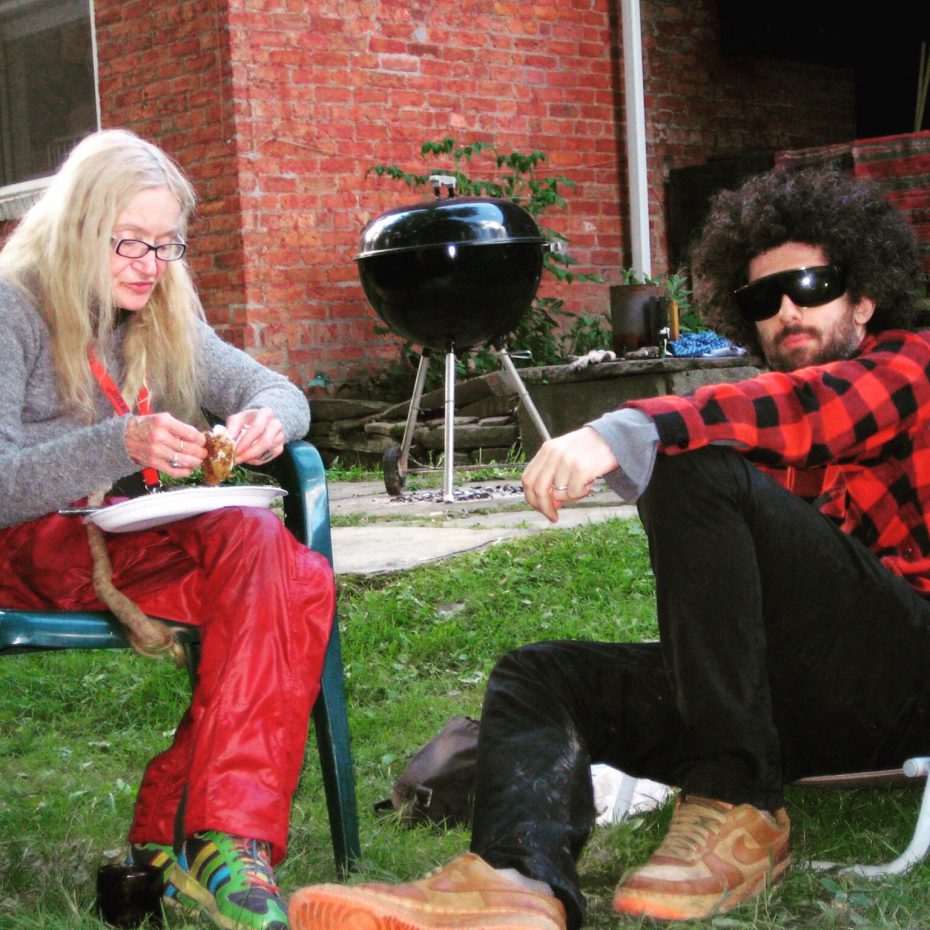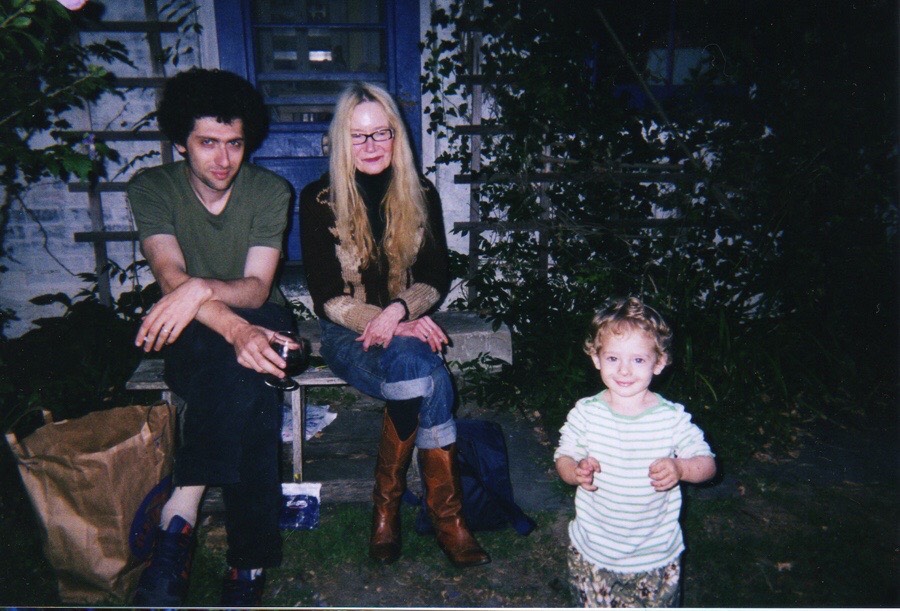By Raz Mesinai, UPA Co-founder
In memory of composer and innovator Maryanne Amacher…
She was a phenomenon, a virtuoso of the sound system and a master of the act of listening who never stopped redefining what music is, was and can be, but the thing missing from a lot of writing about Maryanne are the personal aspects that only people who knew her well can provide and I am lucky enough to have been one of those people so I will try to briefly release some of my experiences with her on the ten year anniversary of her untimely death.
I will never forget the first day Maryanne called me and left a message on my voicemail after hearing a record of mine given to her by Naut Humon of Asphodel Records and Recombinant Media Labs (who she hilariously nick named “Naughty”) and invited me to a premier of a new work by her in NYC. Upon arriving at the installation I was prepared for something extreme, but nothing could really prepare me for this.

Maryanne Amacher and Raz Mesinai, Rhinebeck NY
People were leaving in droves as I entered as if they had been traumatized by a terrorist attack, not because the music was bad, or even really loud, although that would be how someone new to her work might describe it, but because it was the most intense combination of both a physical and psychological sonic experience I had ever witnessed before, It was the first music that I could honestly say I was afraid to hear, and I always want to go deeper inside places that scare me. As I closed my eyes and took it in, I noticed that intense physical pressures, like needle pricks around various areas of my ears and neck, as if the sound was giving me acupuncture.
Pretty soon I became overwhelmed when the physical reaction set off a psychological reaction, until someone softly touched my arm bringing me back to the physical realm. I opened my eyes and looked down and there she was, smiling up at me. Maryanne dressed in a technicolor jumpsuit for space travel, with red lipstick so bright I could actually see it in the dark room filled with loud speakers. She gestured for me to come closer and said into my ear “do you feel those prickles?” she asked, “Yes!” I answered, “fantastic” she replied, and began swaying back and forth to the music while taking out a pack of Tops rolling tobacco.
What I was experiencing, she later explained, was a part of her main field of expertise, Otoacoustic emissions (or OAE’s). Although there is extensive research done on this phenomenon, Maryanne was the first to really produce something from it. When Maryanne’s sound is heard on a sound system that is prepared according to her specifications, the hair cells in the cochlea respond to sound by vibrating, which produces sound that echoes back into the middle ear. Still to this day, no one really indulges in this idea to the extent that she did, because it leads one down a rabbit hole of questioning and redefining how music and sound is heard and understood.
To open the “third ear”, as she called it, all of these components had to be exact to her specifications, without compromise. Everything from the sound to the speakers to the cables and amplifiers were carefully thought out and tested, at times driving engineers lucky enough to work for her to the brink of insanity (I met one that was bed ridden for weeks and prescribed sedatives from the stress).
After she finished rolling her cigarette we left together and had a smoke outside where we discussed her piece, the theories and science behind it, of which I had many questions, and she told me about her early years as a child listening to freight trains in Pennsylvania, as her father worked on them, which immediately clarified everything for me. She spent an equal amount of time asking me questions about my own work, and so from that night forward we became close friends, and for many years I began traveling to her house in Kingston New York any chance I could get, where we would drink, smoke, talk and share ideas that still remain with me today.

Maryanne Amacher and Raz Mesinai, Kingston NY
Her house resembled an alchemists laboratory, with living organisms growing in glass test tubes on shelves and stones in the sink of her kitchen, something I never had the chance to ask about. Squirrels, birds and raccoons entered through holes in her rooftop and ran amok in her house, knocking things over and leaving the place in disarray when she was not home, which was not always clean to begin with.
When it was time to “sound out”, as we liked to call it, she would rev up the engines of her oscillators and begin to build a force field around us, not so much a wall, as that conjures an image that seems too restrictive to describe the experience, and not so much a tsunami, as that describes something closer to noise (and her work was neither accidental nor improvised as some may say), she would quite simply make sound that was impossible to escape from.
Her and I would love to discuss how one could make sound that could not be degraded by the sound systems of the future, which now seems prophetic when we look at how most concerts are transmitted to a broader audience through tiny loudspeakers on mobile devices. That was the point, after all, that we hear it, and she went many steps further, to make music that insisted we hear what our ears heard, as opposed to what WE hear, because Maryanne was always more interested in how we perceive music than the music itself, and I think this was one of the links between us.
To most a recording must be finalized and set in stone, but we tend to ignore the enemies of a final mix, which are the sound systems used, the acoustical spaces the playback of the recording takes place in, and the actual eardrums of the audience themselves, because, unlike sound systems, eardrums cannot be chosen, at least not yet (and her work nods towards a future of trans-human technologies of enhancing the human ear).
She would write down by hand the frequency combinations that produced the effects she desired onto index cards like spells, and then continue destroying my mind with sound, her blonde dreadlocks waving back and forth as she danced in her own way to these pulses, exposing bare the microcosm that is sonic vibration, making us hear the rhythms that are within rhythms, shattering any misconceptions we have of the existence of time.
Then there were the not so productive nights where she would drink far too much alcohol for her small frail body to absorb while eating very little solid foods, I would have to carry her inside of her house, usually a bit drunk myself, and place her in the chair by her mixing desk and tucked her under a blanket, knowing that she would most likely attempt to light up a cigarette on her own after I left and then pass out with it lit and light her entire tinder house on fire and be killed, I would wait it out till she was fully unconscious to take the lit cigarette away from her bony fingers, because even if she was remotely conscious, she would certainly light up another one.
As she nodded off she would speak of random things, like the Transformer Movies, which she had a real fascination with, until eventually, mid sentence, she’d fall asleep. I would then remove all cigarettes and lighters from the vicinity, check all power sockets for anything dangerous, and pray as I left that nothing would happen to harm her or her work.
It is this memory that still haunts me to this day because while back at my home in NYC a few months later I got the call that she had fallen while unattended at a party at Bard College and later went into a coma. The next time I saw her, she was in a bed in the Kingston hospital, surrounded by a far less impressive array of electronic instruments and loud speakers than she had at home, the life support system measuring the pulse of her unique heart, I sat with her, listening to the tones and bleeps of the hospital machines which were not really keeping her alive, but merely representing that she had not died yet, just like we spoke of. I held her hand and cried, knowing that when her life was over, all that would be heard would be the sound of an unwavering pure tone sine wave.
The crowd at her funeral was certainly smaller than it should have been and before being the first to shovel the dirt with little said I took out a pack of Tops Tobacco and poured it over her uncovered grave. Back to the earth you go dear friend, and if that is not where you came from, please, forgive us.
https://www.youtube.com/watch?v=_MahrtRVhkA



Leave a reply